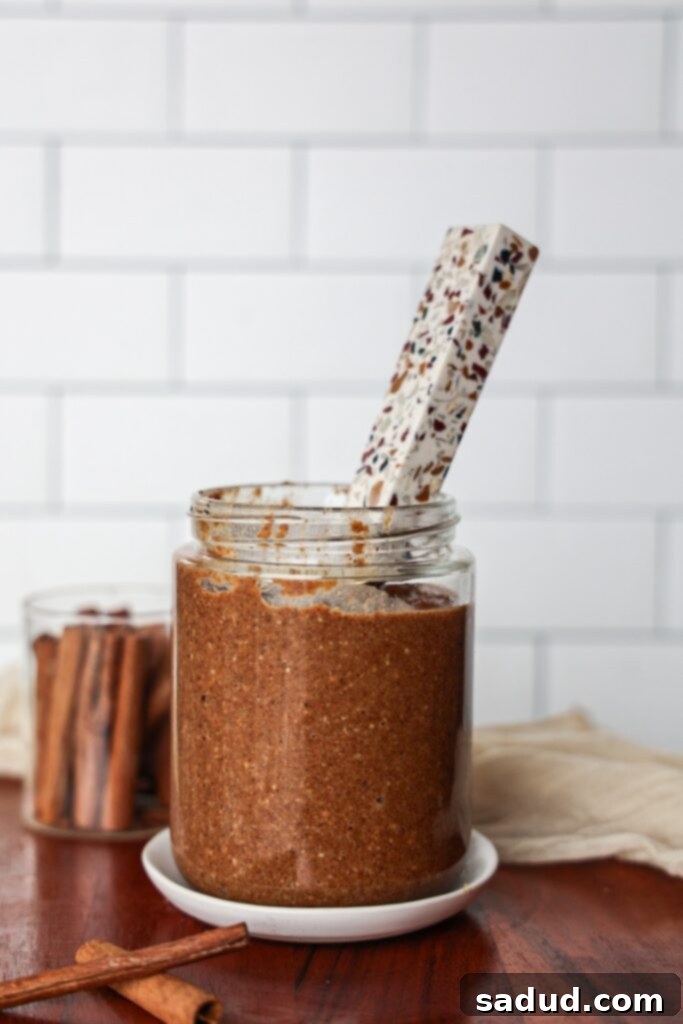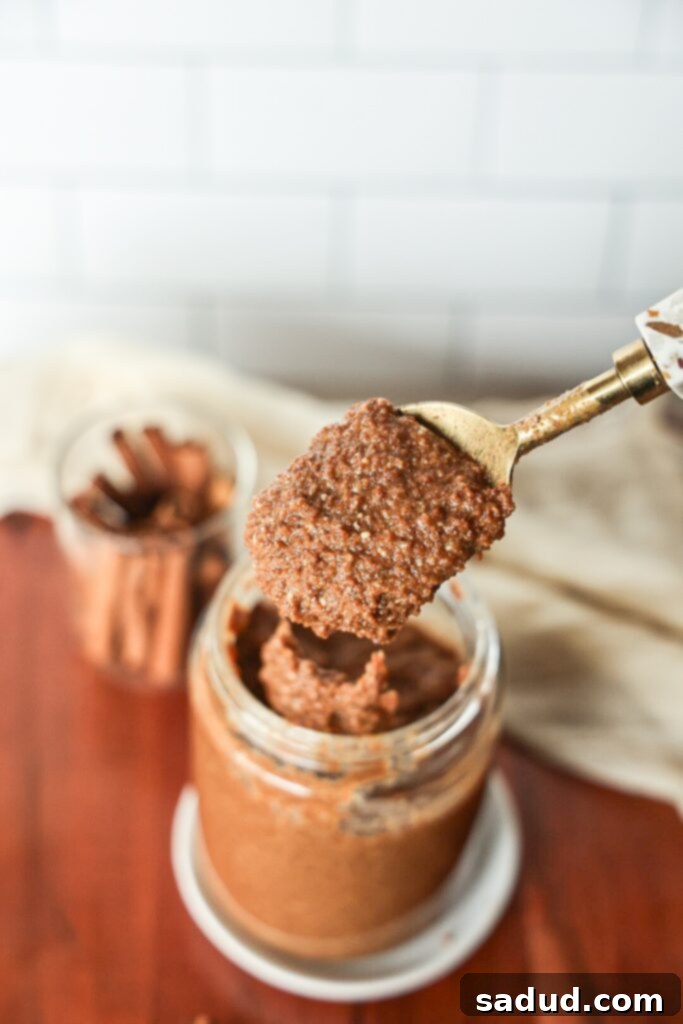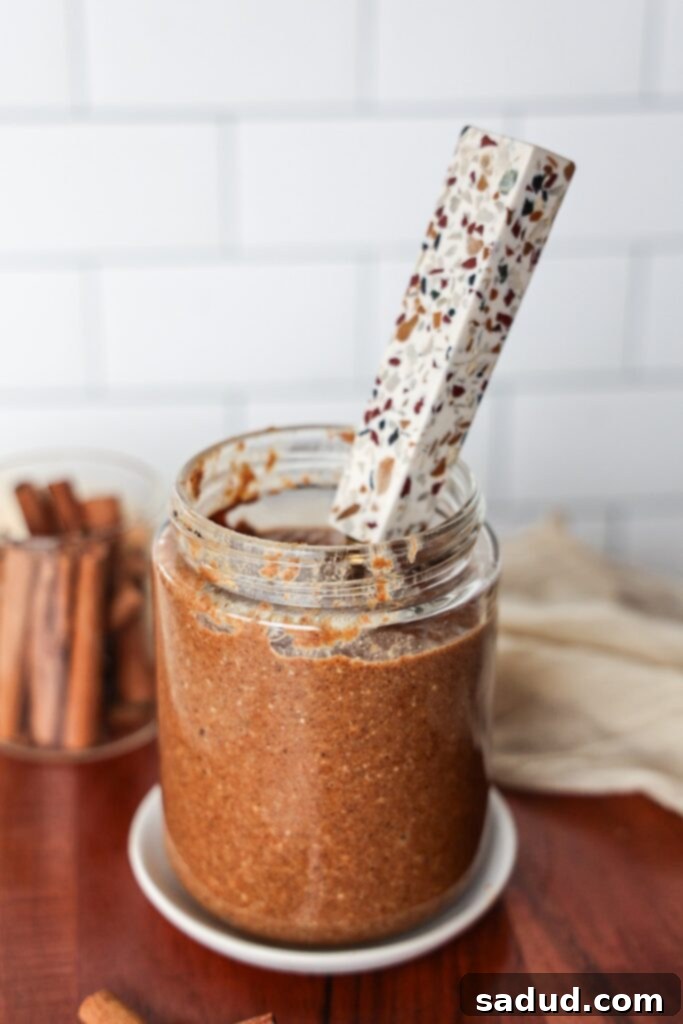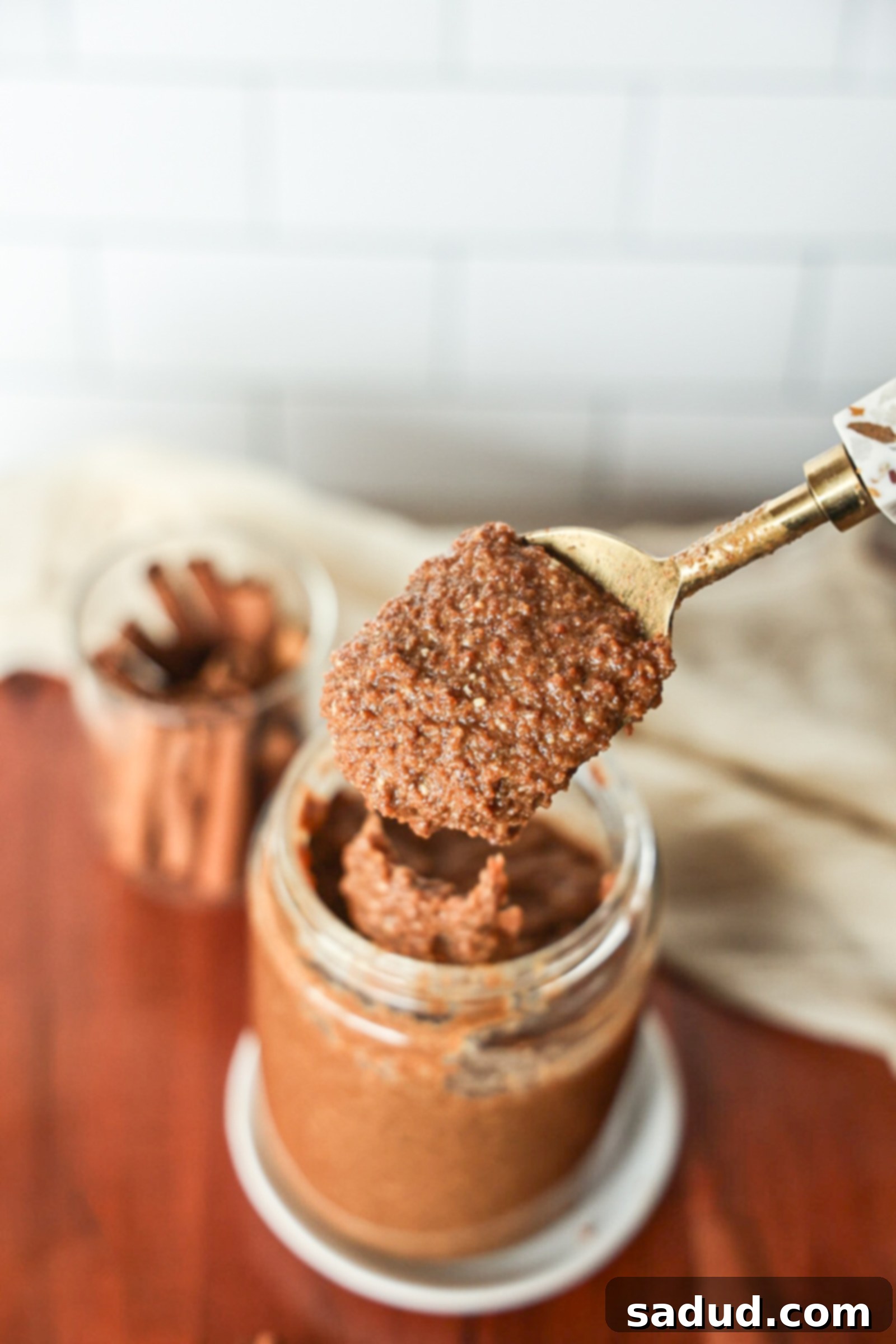The Ultimate Guide to Healthy Homemade Gluten-Free Cookie Butter (2 Easy Methods)
Imagine a spread so luxuriously creamy, unbelievably smooth, wonderfully sticky, and bursting with the delightful taste of toasted, spiced cookies. Now, imagine it being healthy and homemade! This comprehensive guide will show you how to create the most irresistible gluten-free cookie butter right in your own kitchen. We’ll explore two distinct methods: one leveraging healthy store-bought cookies for ultimate convenience, and another using simple pantry ingredients for a completely from-scratch experience. Both approaches yield a product that’s incredibly easy to make, fully customizable, and perfect for spreading on toast, swirling into desserts, or enjoying by the spoonful!

Why You’ll Fall in Love with This Homemade Cookie Butter Recipe
- Unrivaled Health Benefits: Say goodbye to butter, excessive added sugars, and questionable preservatives found in most commercial cookie butters. Our homemade version is crafted without butter and refined sugar, making it a much healthier indulgence without compromising on flavor. In fact, many find it even more delicious than its store-bought counterparts!
- Two Convenient Methods: Whether you’re short on time or prefer to build your flavors from the ground up, this recipe has you covered. Choose between our quick method using wholesome store-bought cookies or our entirely from-scratch approach with pantry staples. Both deliver fantastic results.
- Wholesome & Nourishing Ingredients: We prioritize your well-being by using only nourishing, natural ingredients. Free from refined sugar, artificial flavors, preservatives, and additives, this homemade recipe is a guilt-free pleasure you can feel good about enjoying and sharing.
- Dietary Inclusivity: This recipe is designed to fit a variety of dietary needs. It’s naturally vegan, gluten-free, and refined sugar-free, making it accessible for those with allergies, intolerances, or specific lifestyle choices.
- Effortless & No-Bake: Forget complicated baking processes or specialized equipment. All you need is a reliable food processor and a few minutes of your time. This no-bake recipe is a testament to how easy it can be to create something truly extraordinary in your kitchen.
- Customizable Flavor Profile: The beauty of making your own cookie butter lies in the ability to adjust spices and sweetness to your exact preference. Love extra cinnamon? Go for it! Prefer a stronger ginger kick? Add more!
Homemade Gluten-Free Cookie Butter Recipe Video
Is Cookie Butter Healthy? A Deep Dive into Ingredients
When it comes to “healthy,” homemade cookie butter stands head and shoulders above most store-bought varieties. The primary advantage of crafting your own is the complete control you gain over every single ingredient, ensuring a nourishing and wholesome spread for yourself and your family. Let’s starkly compare the typical store-bought ingredients with what goes into our healthier homemade version.
The Store-Bought Reality: Lotus Biscoff Cookie Butter Ingredients
A look at a popular commercial option, Lotus Biscoff Cookie Butter, reveals a list that, while delicious, is not optimized for health:
- Biscoff cookies: This is the foundation, and typically includes Wheat flour (a common allergen and gluten source), Sugar, Vegetable oils (often a blend of soybean oil, sunflower oil, canola oil, palm oil – many of which are highly processed and high in omega-6 fatty acids), Brown sugar syrup, Sodium bicarbonate (leavening), Soy flour, Salt, Cinnamon.
- Additional Ingredients: Canola oil (more processed vegetable oil), Sugar (additional refined sugar), Soy lecithin (an emulsifier, often derived from GMO soy), Citric acid.
Key concerns here include the prevalence of wheat and gluten, multiple forms of refined sugar, and a variety of seed oils that can be inflammatory when consumed in excess. While it “does not contain nuts,” it often contains soy, which can be another common allergen.
The Wholesome Alternative: Dani’s Homemade Gluten-Free Cookie Butter Ingredients
When you take the reins in your kitchen, you can craft a spread that aligns with your health goals and dietary needs. My recipe focuses on nutrient-dense ingredients that deliver incredible flavor without compromise:
- Raw cashews: These form the creamy base, providing healthy fats, protein, and essential minerals like magnesium and zinc. They transform into a rich, buttery paste in the food processor.
- Warm Spices: Cinnamon, ginger, nutmeg, and cloves are not just for flavor; they’re packed with antioxidants and anti-inflammatory properties, giving our cookie butter its signature “spiced cookie” taste. A tiny pinch of cardamom is optional for an extra layer of complexity.
- Coconut oil or grass-fed butter: Refined coconut oil is an excellent vegan fat source, offering medium-chain triglycerides (MCTs) and a neutral flavor. Grass-fed butter (or ghee) can also be used for those who prefer dairy, adding a rich, authentic buttery note and beneficial fat-soluble vitamins.
- Molasses: This dark, sticky syrup is crucial for that deep, caramelized “speculoos” flavor. It also provides a touch of iron and other minerals.
- Coconut sugar & Maple Syrup: These are unrefined sweeteners with a lower glycemic index compared to white sugar. Coconut sugar offers a caramel-like flavor, while maple syrup adds a subtle sweetness and liquid consistency. For a lower-sugar or keto option, monk fruit sweetener can be used.
- Vanilla extract: A must-have flavor enhancer that ties all the ingredients together.
- Sea salt: Balances the sweetness and enhances all the other flavors, making them pop.
By choosing these ingredients, we create a cookie butter that is naturally vegan, gluten-free, dairy-free, and refined sugar-free, making it a truly healthier and guilt-free indulgence.

How to Make Homemade Gluten-Free Cookie Butter: Two Simple Methods
Get ready to create magic in your kitchen! Below, I’ll walk you through two distinct yet equally delicious methods for crafting healthier homemade gluten-free cookie butter. The full recipe details, including precise measurements, are conveniently located in the recipe card at the bottom of this post.
Essential Equipment for Both Methods
Good news – you don’t need a lot of fancy tools for this recipe. Here’s what you’ll need:
- Small pan: Only needed for roasting cashews in Method Two.
- Food processor: This is your star player, essential for achieving that silky-smooth texture. A high-powered blender can also work, especially if you prefer an even finer consistency.
- Storage jar: For keeping your delightful creation fresh and ready to enjoy.
Method One: The Speedy Store-Bought Simple Mills Cookies Approach
This method is perfect for those busy days when you crave homemade goodness but are short on time. Simple Mills offers a fantastic range of paleo-friendly, vegan, and gluten-free cookies made with wholesome ingredients. Utilizing these already-delicious cookies provides a convenient shortcut to a spectacular cookie butter.
Ingredients for Method One:
- Simple Mills Toasted Pecan Cookies: These cookies are ideal for their robust flavor profile and excellent ingredient list. The toasted pecan flavor adds another layer of depth to the cookie butter.
- Plant-based milk, of choice: Almond, cashew, or oat milk work wonderfully to help achieve the desired creamy consistency. You can use regular milk if not dairy-free.
- Coconut oil: Helps create a smooth, rich texture and a subtle hint of tropical flavor. Ensure it’s softened for easier blending.
- Vanilla extract, cinnamon, nutmeg, sea salt: These essential spices and flavorings enhance the “cookie” taste and balance the sweetness, giving it that classic spiced cookie butter warmth.
Step-by-Step Instructions for Method One:
- Process the Cookies: Begin by adding the entire box of Simple Mills Toasted Pecan Cookies to your food processor. Pulse and process until the cookies are reduced to a fine, flour-like crumb. The finer the texture, the smoother your final cookie butter will be. Scrape down the sides of the bowl as needed to ensure even processing.
- Add Liquids & Spices: Once the cookies are finely ground, add the plant-based milk, softened coconut oil, vanilla extract, cinnamon, nutmeg, and a pinch of sea salt to the food processor.
- Blend Until Smooth: Secure the lid and blend again continuously. At first, it might look crumbly, but as you continue to process, the ingredients will emulsify and transform into a wonderfully smooth and creamy spread. Keep blending, scraping down the sides every minute or so, until your cookie butter reaches your desired silky consistency. If you prefer a runnier texture, add a tiny bit more milk or coconut oil, a teaspoon at a time, until it’s perfect.
- Store & Enjoy: Transfer your freshly made cookie butter to an airtight container or jar. Store it in the refrigerator to maintain its freshness and consistency. It will firm up slightly when chilled.

Method Two: Crafting Cookie Butter from Pantry Ingredients (From Scratch)
For those who love the art of cooking from scratch or simply don’t have access to healthier store-bought cookie options, this method is for you. Using basic pantry staples, you can create an incredibly flavorful and wholesome gluten-free cookie butter that truly tastes like spiced cookies. This approach gives you maximum control over every flavor note and ingredient quality.
A Deep Dive into the Ingredients for Method Two:
- Raw cashews or cashew butter (see tips & notes): Raw cashews are the secret to the incredibly creamy base. When processed, their natural oils release, creating a luxurious, buttery texture. If you’re short on time, good quality store-bought cashew butter can be a fantastic shortcut, just ensure it’s unsweetened and ideally made with only cashews.
- Coconut sugar: This unrefined sweetener offers a lovely caramel-like flavor that complements the spiced notes. You can use brown sugar if you’re not strictly refined sugar-free, but coconut sugar provides a healthier alternative. For a truly sugar-free option, golden monk fruit sweetener works beautifully.
- Maple syrup: Adds another layer of natural sweetness and helps to achieve the perfect drippy consistency. Use pure maple syrup for the best flavor.
- Refined coconut oil, grass-fed butter, or vegan butter:
- Refined coconut oil: This is generally the best option for a neutral flavor profile, as virgin coconut oil can impart a strong coconut taste. It helps with the spreadable consistency and richness.
- Grass-fed butter or vegan butter: For those who aren’t dairy-free, grass-fed butter can add a rich, authentic buttery flavor that enhances the “cookie” experience. Similarly, a high-quality vegan butter can provide a similar depth for a dairy-free version. Ensure your chosen fat is softened for optimal blending.
- Blackstrap molasses: This is an optional but highly recommended ingredient. It provides that distinctive deep, slightly bitter, and caramelized spiced flavor that is characteristic of traditional speculoos or Biscoff cookies. It also adds a rich dark color.
- Vanilla extract: A flavor essential that enhances all the sweet and spiced notes.
- Spices: A robust blend of cinnamon, nutmeg, ground ginger, and cloves is crucial for replicating the classic spiced cookie flavor. These spices not only taste incredible but also boast impressive health benefits. A tiny pinch of cardamom can be added for an even more complex aroma.
- Sea salt: A small amount of sea salt is vital for balancing the sweetness and intensifying the overall flavor profile of your cookie butter.
Step-by-Step Instructions for Method Two:
- Roast the Cashews: Preheat your oven to 350°F (175°C). Spread the raw cashews in a single layer on a parchment-lined baking sheet. Roast them for about 10 minutes, or until lightly golden and fragrant. Roasting enhances their nutty flavor and helps them release their natural oils more easily during processing. Let them cool for a few minutes before proceeding.
- Process Cashews to a Paste: Transfer the cooled roasted cashews to your food processor. Begin to process them. This is where patience is key! Initially, the cashews will turn into a coarse meal, then a finer flour. Continue processing, scraping down the sides of the bowl frequently. Over several minutes (it can take 5-10 minutes, depending on your food processor), the cashews will release their oils and eventually form a thick, creamy paste or even a ball. Keep going until it’s as smooth as possible.
- Add Remaining Ingredients & Blend: Once the cashews have transformed into a smooth paste, stop the food processor. Add the refined coconut oil (or butter), molasses, coconut sugar, maple syrup, vanilla extract, cinnamon, ginger, nutmeg, cloves (if using cardamom), and sea salt.
- Blend Until Silky Smooth: Resume blending all ingredients together. Continue to process for several more minutes, scraping down the sides periodically. The mixture will gradually become thinner and smoother, eventually reaching a luxurious, drippy, and creamy nut butter consistency. Blend until it’s perfectly smooth and all the spices are well incorporated.
- Store Your Homemade Delight: Transfer the finished cookie butter to a clean, airtight container or jar. Store it in the fridge for optimal freshness. It will firm up slightly when chilled, so let it sit at room temperature for a few minutes before using if you prefer a softer spread. Alternatively, it can be stored in a dark, cool pantry if you plan to consume it within a week or two.
Expert Tips for Perfect Homemade Cookie Butter Every Time
- Achieving Ultimate Smoothness: While a food processor works wonderfully, if you desire an ultra-silky, absolutely lump-free cookie butter, a high-speed blender can achieve an even smoother consistency. However, if you enjoy a slight textural element, a food processor is perfectly fine.
- Time-Saving Shortcut: To significantly reduce preparation time, you can substitute store-bought cashew butter for the raw cashews in Method Two. Use 1 to 1 1/4 cups of unsweetened, plain cashew butter. Start with 1 cup and blend with the remaining ingredients, then add more if needed to reach the desired consistency and to balance the flavors.
- Keto/Low Sugar Variation: For a sugar-free or low-carb version, opt for a golden monk fruit sweetener in place of coconut sugar and adjust the maple syrup or omit it if you prefer. Taste as you go to achieve your desired sweetness level.
- Adjusting Consistency: If your cookie butter is too thick, add a teaspoon of plant-based milk or melted coconut oil at a time, blending until you reach your desired drippy consistency. If it’s too thin, a bit more ground cashews or even a tablespoon of coconut flour (for the scratch method) can help, but be mindful of flavor.
- Flavor Customization: Feel free to experiment with the spice blend! Add a tiny pinch of cardamom for an extra layer of warmth, or increase the ginger for a spicier kick. You can also add a pinch of black pepper for a truly unique depth of flavor, much like in some traditional spiced cookies.
- Storage Best Practices: Homemade cookie butter, without preservatives, is best stored in an airtight container in the refrigerator. It typically lasts for up to 2-3 weeks. If it hardens too much in the fridge, simply let it sit at room temperature for 15-30 minutes, or gently warm it in a microwave-safe dish for a few seconds until it softens.
Creative Ways to Use Your Delicious Homemade Cookie Butter
Once you’ve made a batch of this incredible gluten-free cookie butter, the possibilities are endless! It’s so versatile, you’ll find yourself reaching for it constantly.
- Classic Spread: The most obvious, yet incredibly satisfying, way to enjoy it! Spread generously on toast, bagels, rice cakes, or your favorite gluten-free crackers.
- Fruit Dip: Dip fresh apple slices, banana chunks, pear slices, or even strawberries into this creamy delight for a healthy and delicious snack.
- Dessert Topping: Drizzle it over oatmeal, pancakes, waffles, or crepes for an instant upgrade to your breakfast or brunch.
- Yogurt Parfait Booster: Stir a tablespoon or two into plain Greek yogurt or coconut yogurt. Layer it with fresh berries and your favorite granola for an indulgent yet wholesome yogurt parfait. It would be absolutely amazing in my Strawberry Cheesecake Parfaits!
- Baking & Desserts: Use it as a frosting for cupcakes or cakes, swirl it into brownie batter, or even incorporate it into your favorite cookie dough recipe for a double cookie delight.
- Smoothie Enhancer: Add a tablespoon or two into your morning smoothie for a boost of healthy fats, flavor, and creaminess. It pairs wonderfully with banana, cinnamon, and a hint of vanilla.
- Ice Cream Swirl: Swirl warmed cookie butter into homemade or store-bought ice cream for a delightful treat.
- Energy Bites: Use it as a binder in no-bake energy bites or granola bars for a delicious spiced flavor.
- Warm Drink Stir-In: Stir a spoonful into your hot coffee, tea, or warm milk for a cozy, spiced beverage.
More Healthy Recipes to Try from Dani’s Healthy Eats
If you loved this healthy homemade spread, be sure to explore more delicious and wholesome recipes from my kitchen:
- Pumpkin Spice Infused Maple Syrup
- Easy Whipped Honey
- Strawberry Whipped Honey
- Blender Banana Coffee Cake Muffins
- The Best Gluten-Free, Dairy-Free, Nut-Free Pancakes
- Blueberry Chia Pudding with Lemon Cashew Cream
- Strawberry Chia Overnight Oats
- Snickers Banana Bread
- Strawberry Cheesecake Parfaits

Homemade Gluten-Free Cookie Butter
Pin Recipe
5 minutes
25 minutes
30 minutes
Appetizer, Breakfast, Dessert, Snack
American
Ingredients
Cashew Cookie Butter From Scratch (Method Two)
- 2 cups raw cashews
- 1 tbsp refined coconut oil, grass-fed butter or ghee, or vegan butter
- 1 tbsp light molasses or maple syrup
- 3 tbsp coconut sugar (I used 3 tbsp monk fruit for lower sugar)
- 3 tbsp maple syrup
- 1 1/4 tsp cinnamon
- 1/2 tsp ground ginger
- 1/4 tsp nutmeg
- tiny pinch of cardamom (optional)
- 2 tsp vanilla extract
- 1/2 tsp sea salt
Using Store-Bought Cookies (Method One)
- 1 box toasted pecan Simple Mills cookies
- 1/4 cup plant-based or regular milk
- 1 1/2 tsp cinnamon
- 1/4 tsp nutmeg
- 1 tsp vanilla extract
- 2 tbsp softened refined coconut oil
Instructions
From Scratch Cookie Butter (Method Two)
-
Roast the cashews: Spread raw cashews in a single layer on a parchment-lined cookie sheet and roast in the oven for 10 minutes at 350°F (175°C). Let them cool for a few minutes.
-
Add the cooled cashews to a food processor and blend for several minutes, stopping to scrape the sides, until they transform into a smooth, creamy paste. This step requires patience!
-
Once the cashews form a paste (or a ball), stop the food processor and add the remaining ingredients: coconut oil/butter, molasses, coconut sugar, maple syrup, vanilla extract, cinnamon, ginger, nutmeg, cardamom (if using), and sea salt. Process for a few more minutes until it reaches a drippy, creamy, nut butter consistency.
-
Transfer the finished cookie butter to an airtight container or jar. Store it in the fridge or a cool, dark place.
Boxed Cookie Butter (Method One)
-
Add the Simple Mills cookies into your food processor, processing until a fine, flour-like texture is obtained. Then, add the milk, softened coconut oil, cinnamon, nutmeg, and vanilla extract. Blend until completely smooth and creamy.
-
If you are looking for a runnier butter, add a little more milk or coconut oil, one teaspoon at a time, until the desired consistency is achieved. Store in an airtight container in the fridge.
Video
Notes
biscoff cookie butter, cookie butter, gluten-free cookie butter, healthy cookie butter, speculoos, vegan cookie butter
